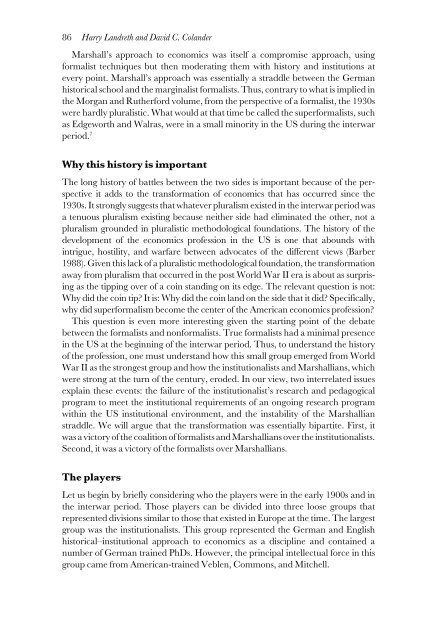Money and Markets: Essays in Honor of Leland B. Yeager
Money and Markets: Essays in Honor of Leland B. Yeager
Money and Markets: Essays in Honor of Leland B. Yeager
You also want an ePaper? Increase the reach of your titles
YUMPU automatically turns print PDFs into web optimized ePapers that Google loves.
86 Harry L<strong>and</strong>reth <strong>and</strong> David C. Col<strong>and</strong>erMarshall’s approach to economics was itself a compromise approach, us<strong>in</strong>gformalist techniques but then moderat<strong>in</strong>g them with history <strong>and</strong> <strong>in</strong>stitutions atevery po<strong>in</strong>t. Marshall’s approach was essentially a straddle between the Germanhistorical school <strong>and</strong> the marg<strong>in</strong>alist formalists. Thus, contrary to what is implied <strong>in</strong>the Morgan <strong>and</strong> Rutherford volume, from the perspective <strong>of</strong> a formalist, the 1930swere hardly pluralistic. What would at that time be called the superformalists, suchas Edgeworth <strong>and</strong> Walras, were <strong>in</strong> a small m<strong>in</strong>ority <strong>in</strong> the US dur<strong>in</strong>g the <strong>in</strong>terwarperiod. 7Why this history is importantThe long history <strong>of</strong> battles between the two sides is important because <strong>of</strong> the perspectiveit adds to the transformation <strong>of</strong> economics that has occurred s<strong>in</strong>ce the1930s. It strongly suggests that whatever pluralism existed <strong>in</strong> the <strong>in</strong>terwar period wasa tenuous pluralism exist<strong>in</strong>g because neither side had elim<strong>in</strong>ated the other, not apluralism grounded <strong>in</strong> pluralistic methodological foundations. The history <strong>of</strong> thedevelopment <strong>of</strong> the economics pr<strong>of</strong>ession <strong>in</strong> the US is one that abounds with<strong>in</strong>trigue, hostility, <strong>and</strong> warfare between advocates <strong>of</strong> the different views (Barber1988). Given this lack <strong>of</strong> a pluralistic methodological foundation, the transfor mationaway from pluralism that occurred <strong>in</strong> the post World War II era is about as surpris<strong>in</strong>gas the tipp<strong>in</strong>g over <strong>of</strong> a co<strong>in</strong> st<strong>and</strong><strong>in</strong>g on its edge. The relevant question is not:Why did the co<strong>in</strong> tip? It is: Why did the co<strong>in</strong> l<strong>and</strong> on the side that it did? Specifically,why did superformalism become the center <strong>of</strong> the American econ omics pr<strong>of</strong>ession?This question is even more <strong>in</strong>terest<strong>in</strong>g given the start<strong>in</strong>g po<strong>in</strong>t <strong>of</strong> the debatebetween the formalists <strong>and</strong> nonformalists. True formalists had a m<strong>in</strong>imal presence<strong>in</strong> the US at the beg<strong>in</strong>n<strong>in</strong>g <strong>of</strong> the <strong>in</strong>terwar period. Thus, to underst<strong>and</strong> the history<strong>of</strong> the pr<strong>of</strong>ession, one must underst<strong>and</strong> how this small group emerged from WorldWar II as the strongest group <strong>and</strong> how the <strong>in</strong>stitutionalists <strong>and</strong> Marshallians, whichwere strong at the turn <strong>of</strong> the century, eroded. In our view, two <strong>in</strong>terrelated issuesexpla<strong>in</strong> these events: the failure <strong>of</strong> the <strong>in</strong>stitutionalist’s research <strong>and</strong> pedagogicalprogram to meet the <strong>in</strong>stitutional requirements <strong>of</strong> an ongo<strong>in</strong>g research programwith<strong>in</strong> the US <strong>in</strong>stitutional environment, <strong>and</strong> the <strong>in</strong>stability <strong>of</strong> the Marshallianstraddle. We will argue that the transformation was essentially bipartite. First, itwas a victory <strong>of</strong> the coalition <strong>of</strong> formalists <strong>and</strong> Marshallians over the <strong>in</strong>stitutionalists.Second, it was a victory <strong>of</strong> the formalists over Marshallians.The playersLet us beg<strong>in</strong> by briefly consider<strong>in</strong>g who the players were <strong>in</strong> the early 1900s <strong>and</strong> <strong>in</strong>the <strong>in</strong>terwar period. Those players can be divided <strong>in</strong>to three loose groups thatrepresented divisions similar to those that existed <strong>in</strong> Europe at the time. The largestgroup was the <strong>in</strong>stitutionalists. This group represented the German <strong>and</strong> Englishhistorical–<strong>in</strong>stitutional approach to economics as a discipl<strong>in</strong>e <strong>and</strong> conta<strong>in</strong>ed anumber <strong>of</strong> German tra<strong>in</strong>ed PhDs. However, the pr<strong>in</strong>cipal <strong>in</strong>tellectual force <strong>in</strong> thisgroup came from American-tra<strong>in</strong>ed Veblen, Commons, <strong>and</strong> Mitchell.
















